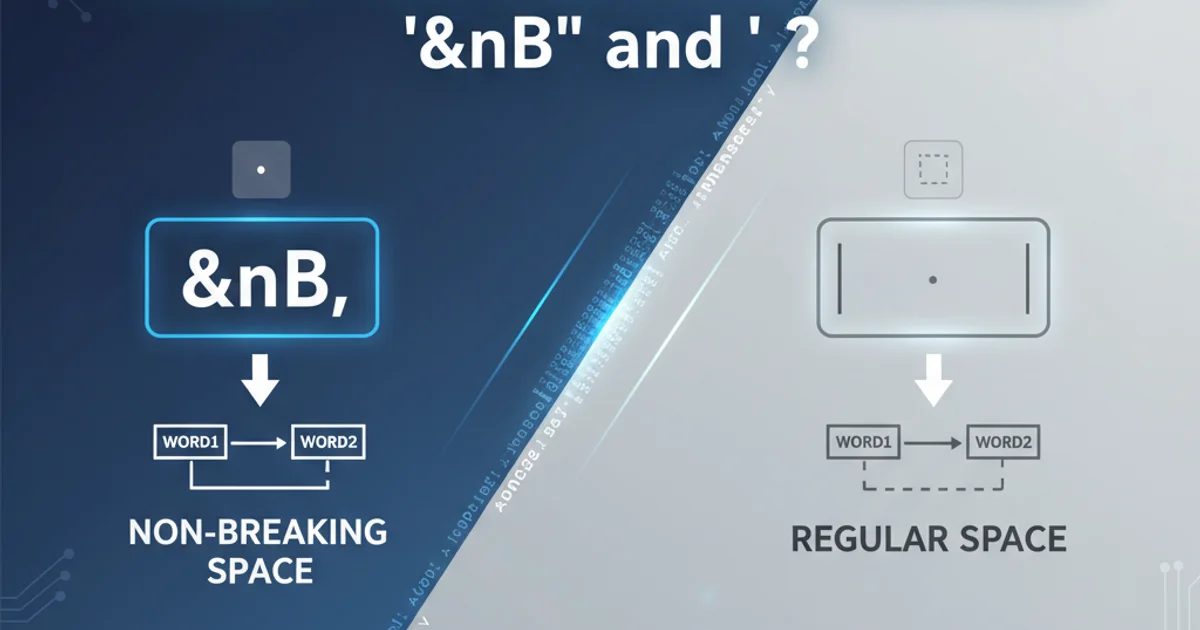What's the difference between " " and " "?
Categories:
Understanding Whitespace: vs. Space Character

Explore the fundamental differences between the non-breaking space entity ( ) and the regular space character ( ) in HTML, and learn when to use each for optimal layout and accessibility.
In web development, controlling whitespace is crucial for layout, readability, and consistency. While a simple space character ( ) might seem straightforward, HTML offers another, more powerful option: the non-breaking space entity, . Understanding the nuances between these two is essential for crafting robust and predictable web content. This article will delve into their characteristics, use cases, and implications for your web projects.
The Regular Space Character ( )
The regular space character, often referred to as a 'soft space', is the most common form of whitespace. It's what you get when you press the spacebar on your keyboard. Its primary characteristic is that browsers can collapse multiple consecutive spaces into a single space, and they can also break lines at a regular space if necessary to fit content within its container. This behavior is generally desirable for fluid text flow, but it can lead to unexpected wrapping or spacing issues in specific contexts.
<p>This is a sentence with multiple spaces.</p>
<p>This is a sentence with a very long word that might break at a space if needed.</p>
Example of regular spaces in HTML. Notice how multiple spaces collapse.
The Non-Breaking Space Entity ( )
The entity stands for 'non-breaking space'. Unlike a regular space, it serves two critical functions:
- Prevents Line Breaks: The browser will not break a line of text at an
. This is invaluable for keeping words or short phrases together that should never be separated (e.g., '10 kg', 'Mr. Smith', 'Chapter 1'). - Preserves Multiple Spaces: Browsers will render every
you include, preventing the collapsing behavior seen with regular spaces. This allows for precise control over horizontal spacing, though it's often better to use CSS for layout purposes.
<p>The price is $100 USD.</p>
<p>Please refer to Chapter 1, Section 2.</p>
<p>This text has four non-breaking spaces between words.</p>
Examples demonstrating the use of to prevent line breaks and preserve spacing.
flowchart TD
A[User Types Space] --> B{Is it a regular space ' ' ?}
B -->|Yes| C[Browser collapses multiple spaces]
C --> D[Browser allows line break]
B -->|No, is it ' ' ?| E[Browser renders each ' ']
E --> F[Browser prevents line break]
D --> G[Content displayed]
F --> GDecision flow for how browsers handle regular spaces vs. .
can be used to add extra horizontal space, it's generally recommended to use CSS properties like padding, margin, or word-spacing for layout and visual spacing. should primarily be reserved for its non-breaking characteristic.When to Use Which
Choosing between a regular space and depends on the desired behavior:
Use Regular Space (
- General text flow where line breaks are acceptable.
- Separating words in sentences.
- Anywhere you want the browser to manage text wrapping automatically.
Use Non-Breaking Space (
) for:- Keeping numbers and units together (e.g., '50 km/h').
- Ensuring names or titles stay on one line (e.g., 'Dr. Smith').
- Preventing short words or conjunctions from being orphaned at the end of a line (e.g., 'and then').
- Creating small, precise horizontal gaps where CSS isn't practical or necessary (use sparingly).
- When you need to force a space in an otherwise empty HTML element (e.g.,
<td> </td>).
for layout purposes can make your HTML less semantic, harder to maintain, and potentially less accessible. Screen readers might interpret multiple entities differently than visual users perceive them.Accessibility Considerations
From an accessibility standpoint, both types of spaces have implications. Regular spaces are generally well-understood by screen readers. is also typically handled correctly, as it's interpreted as a single space that simply doesn't break. However, using many entities to create large gaps can be problematic, as a screen reader might announce each as a space, leading to a verbose and confusing experience. Always prioritize semantic HTML and CSS for layout over excessive use of .